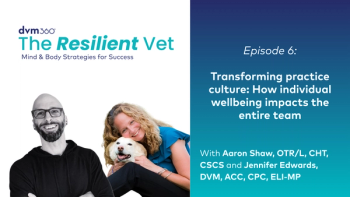
- Firstline March/April 2020
- Volume 16
- Issue 2
3 ways veterinary professionals can reframe negative thinking
Some things in life you dont control. One thing in your control that might help is your own thinking. Check out these proven ways we veterinary professionals can help manage job burnout and compassion fatigue.
Throughout my career as a veterinary technician, I've lived in a constant state of burnout-with a dash of compassion fatigue sprinkled in. Years ago, I was unaware of what was happening to me but figured it was just a normal part of the career path I chose.
I once worked for one of the largest shelters in a big city and felt a strong sense of purpose helping animals that didn't have a home. The workload consistently kept me late, and I ran off of a steady diet of self-inflicted guilt when I finally left: What will happen to this dog if he doesn't get his medication tonight? I don't want anyone to think I don't care. If I stay a little later, maybe I'll feel better about leaving for the day.
I know many veterinary professionals who burn out on their jobs because they continue to make decisions based on guilt. No veterinary professional entered the field because they wanted to make tons of money-they did it because they loved animals. But that dedication to animals can create a work-till-you-drop mentality and guarantee trauma on the job. Let's talk definitions first:
What is burnout?
In May 2019, the World Health Organization recognized burnout as a syndrome resulting from
What is compassion fatigue?
Burnout and compassion fatigue are sometimes used interchangeably, but the American Institute of Stress defines compassion fatigue as
An example from my own life is the time I came home with my first foster pet, a 6-month-old German shepherd puppy. She had a broken front leg that was casted instead of surgically repaired, and she was not potty trained. I came home one day to find her, the kennel and half my kitchen floor covered in poop. As I was cleaning her up, she yelped and tweaked her leg. I rushed her to the shelter for radiographs, which revealed an additional fracture. I was waiting to hear that her surgery went well, but instead was told that she'd stopped breathing and CPR had been unsuccessful. Having worked in shelters, I was not sensitive to death itself, but this was the first dog I'd taken home since losing my own dog only a few months prior. For some, this wouldn't be a traumatic event, but for me it was. My trauma isn't your trauma-but the results are still the same. If we don't develop some resilience, traumatic situations can add up.
3 ways to manage burnout and compassion fatigue
Even with all the lectures, webinars and advice out there for managing burnout and compassion fatigue, many of us still haven't learned the tools or put them into action yet. In case this helps you finally take a step toward self-care, here are some ways I manage:
Let go of negativity. When I was suffering from both burnout and compassion fatigue, there were times I annoyed even myself with how often I complained. I could be at a party having a great time, then someone would ask me about work. I'd feel myself slide into a terrible mood instantly but had no idea how to stop it.
If you're used to holding onto stress, it's time to start learning to let go. You can choose gratitude instead. But beware: When I started trying to focus on gratitude over my negative self-talk, I expected to snap my fingers and never be sucked into complaining ever again. That didn't happen.
Realistically, you have to start small. Try to notice when you're talking in a negative way. Once you notice you want to say something negative to someone, be mindful enough to move onto gratitude. When you're stating gratitude:
- Say it out loud or write it down. Research by bestselling author Brené Brown, PhD, found a common thread with participants who practiced gratitude: They wrote down their gratitude in a journal or stated out loud what they were grateful for every day. My favorite gratitude exercise is using a gratitude journal and setting a goal of writing or stating what I'm grateful for every day.
- Be specific. On a really bad day it can be extremely hard to find something you're grateful for. I usually try to think of three things, and when I say, “I'm grateful today wasn't the worst it could be,” it can be difficult to come up with my three things. Getting specific about what I'm grateful for helps me define what interactions add value to my life and helps me scan my day for the good instead of the bad.
- Practice. The more you practice gratitude, the easier it gets and the better you feel, but
habits can take, on average, 66 days to develop. Still, you should feel effects of habit change much earlier.
Reframe.
- Would I be thinking about this differently if I were in a better mood?
- What am I meant to learn from this situation?
- How could I explain this situation if I were not taking it personally?
You don't need to know the answers to these questions. The goal is to think about where your emotions may be overriding reality and what you do know.
Prioritize self-care. Because you're in a caretaking career, it may feel unnatural to put yourself first. It's easy to go on your one vacation all year just to jump right back into work within hours of getting home. Maybe you finally went to that yoga class after work but gave up after only one session. Many people will “splurge” on self-care in these ways and wonder why they still feel exhausted. Self-care can be like a fad diet-one day or weekend of self-care won't be enough to create a lasting benefit.
It was a hard for me to start prioritizing self-care. I felt guilty putting myself first. I wasn't ready to choose myself until I had no other options. It helped me to say out loud what I was choosing to do that might hurt me when I was worn out: I'm choosing to take an extra shift and not go to the gym. I'm choosing to stay late. I'm choosing not to take my lunch break.
When my choices were out in the open, it got a lot harder to ignore what I knew, deep down, I needed.
As you work to create new habits that can help you better manage job burnout and veterinary compassion fatigue, it's important to remember that you will experience failure. Stress happens. Feelings of burnout happen. Trauma happens. The difference will be whether you can learn from these experiences and continue forward-or if you give up and need to leave the profession.
Kristina Guldbrand worked as a certified veterinary technician for 12 years before becoming an account manager for Veterinary System Services, a company that provides staffing, consulting and hiring help to practices in the Denver, Colorado, area. She has received training through the International Coaching Federation and provides workshops, leadership and wellbeing coaching as well as team-building for practices.
Articles in this issue
about 6 years ago
When the hospital owner undermines your leadershipabout 6 years ago
Clearing up cannabis confusion for veterinary professionalsabout 6 years ago
Pledge to be a veterinary superheroNewsletter
From exam room tips to practice management insights, get trusted veterinary news delivered straight to your inbox—subscribe to dvm360.





